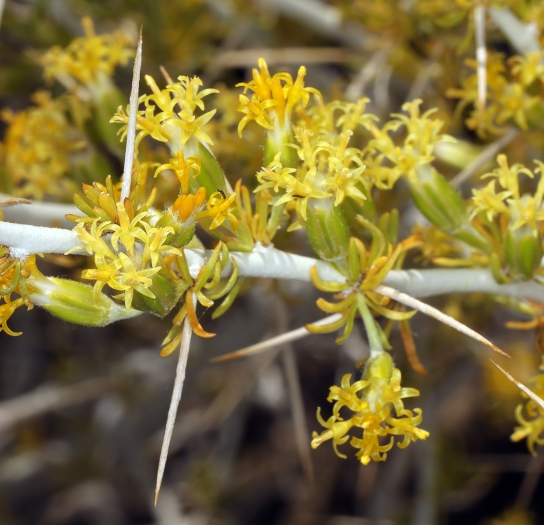Longspine Horsebrush
(Tetradymia axillaris)
Longspine Horsebrush (Tetradymia axillaris)
/
/

Steve Matson
CC BY 4.0
Image By:
Steve Matson
Recorded By:
Copyright:
CC BY 4.0
Copyright Notice:
Photo by: Steve Matson | License Type: CC BY 4.0 | License URL: http://creativecommons.org/licenses/by/4.0/ | Rights Holder: Steve Matson | Publisher: iNaturalist | Date Created: 2022-05-22T12:02-07:00 |























Estimated Native Range
Summary
Tetradymia axillaris, commonly known as longspine horsebrush or cottonthorn, is a deciduous shrub native to the Great Basin and Mojave Desert regions, often found in arid sagebrush communities and desert scrublands. It typically grows to a height of 1-3 feet (0.3-0.9 meters) and spreads out to form dense thickets. The plant is characterized by its spiny green leaves that harden and become sharp spines as they age, providing a unique texture in the landscape. The stems are green and covered with fine hairs, and the plant produces small, yellow, daisy-like flower heads in the axils of new branches during the late spring to early summer. The flowers are not particularly showy but do add a subtle splash of color to the arid landscape. The fruits are achenes that develop a cottony pappus, aiding in wind dispersal.
Longspine horsebrush is valued for its drought tolerance and ability to thrive in poor, well-drained soils, making it suitable for xeriscaping and restoration projects in arid regions. It is also used as a low-maintenance ornamental in rock gardens or as part of a native plant landscape. This shrub requires minimal water once established and prefers full sun exposure. While it is not commonly afflicted by diseases, it can be susceptible to root rot in poorly drained soils. Gardeners should be cautious when handling the plant due to its sharp spines.CC BY-SA 4.0
Longspine horsebrush is valued for its drought tolerance and ability to thrive in poor, well-drained soils, making it suitable for xeriscaping and restoration projects in arid regions. It is also used as a low-maintenance ornamental in rock gardens or as part of a native plant landscape. This shrub requires minimal water once established and prefers full sun exposure. While it is not commonly afflicted by diseases, it can be susceptible to root rot in poorly drained soils. Gardeners should be cautious when handling the plant due to its sharp spines.CC BY-SA 4.0
Plant Description
- Plant Type: Shrub
- Height: 2-5 feet
- Width: 2-3 feet
- Growth Rate: Moderate
- Flower Color: Yellow
- Flowering Season: Spring, Summer
- Leaf Retention: Semi-deciduous
Growth Requirements
- Sun: Full Sun
- Water: Low, Medium
- Drainage: Fast
Common Uses
Drought Tolerant, Erosion Control, Low Maintenance
Natural Habitat
Native to the Great Basin and Mojave Desert regions, often found in arid sagebrush communities and desert scrublands
Other Names
Common Names: Long-Spine Horsebrush
Scientific Names: , Tetradymia axillaris,
GBIF Accepted Name: